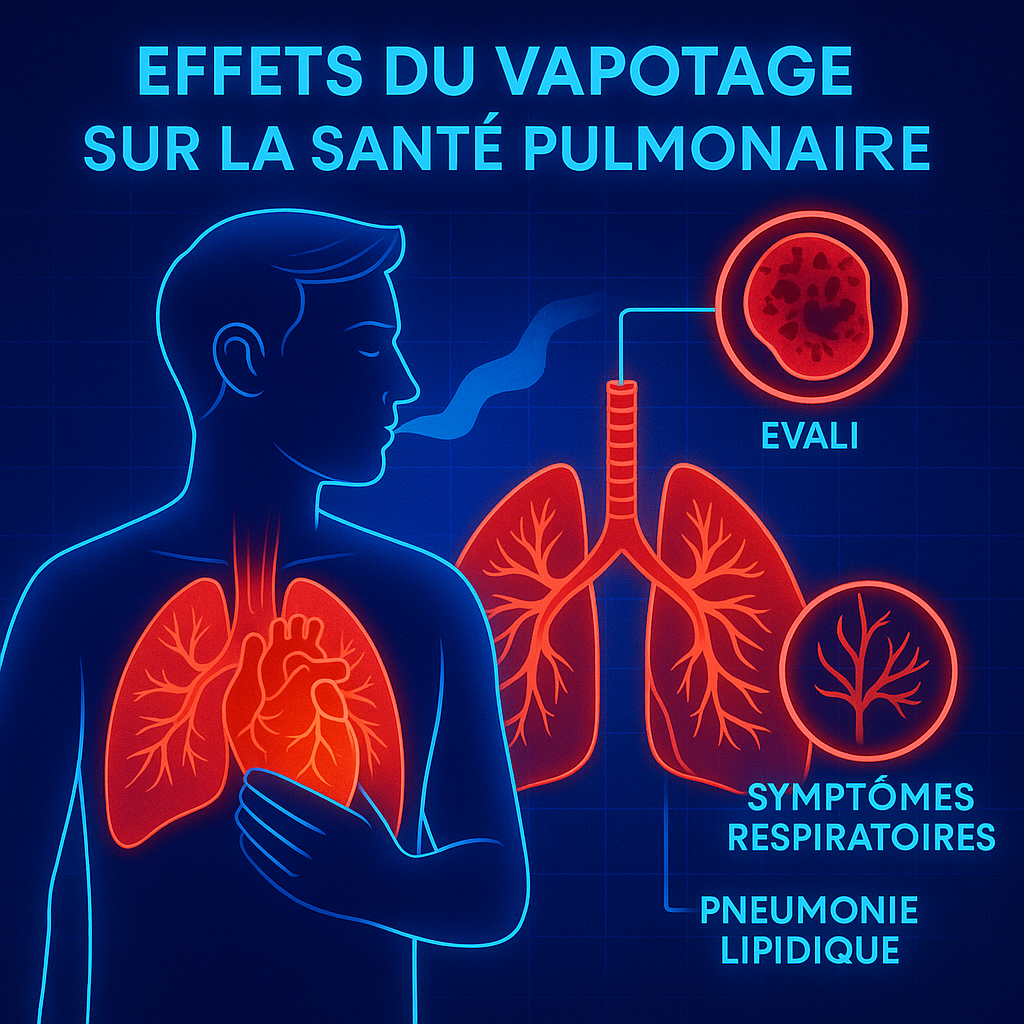Vaping, perceived by many as a less harmful alternative to traditional cigarettes, is increasingly raising questions about its effects on health. Although e-cigarette products are often presented as a solution for quitting smoking, recent studies highlight potential risks associated with their use. This article explores vaping-related illnesses, focusing on effects on the pulmonary and respiratory systems, as well as implications for young people and smokers.

The effects of vaping on lung health
Vaping involves inhalingaerosols produced by heating liquids containing various chemicals, including nicotine. These substances can have harmful effects on lung health.
EVALI: a serious lung disease
EVALI (E-cigarette or Vaping product use-Associated Lung Injury) is an acute lung disease associated with theuse of electronic cigarettes. Cases have been reported in France, Canada and the USA, highlighting the potential dangers of vaping.
Lipid pneumonia and other respiratory conditions
Lipid pneumonia is another vaping-related illness, caused by inhalation of oil-containing liquids.This condition leads to inflammation of the lungs, with symptoms such as persistent cough and shortness of breath.Other respiratory illnesses, such as chronic bronchitis, have also been associated with vaping.
Cardiovascular risks associated with vaping
Nicotine, present in many e-cigarette liquids, is known for its effects on the cardiovascular system. It can increase heart rate and blood pressure, raising the risk of heart disease. Studies have shown that vaping can also affect endothelial function, a key factor in the development of atherosclerosis.
Impact of vaping on young people
Young people are particularly vulnerable to the effects of vaping. Theuse of electronic cigarettes among teenagers is on the increase, partly due to the attractive flavors and the perception that vaping is safe. However, nicotine can affect young people‘s brain development, leading to concentration and memory problems and an increased risk of addiction.

Chemical substances in vaping products
The liquids used in electronic cigarettes contain a variety of chemical substances, some of which are potentially harmful. These include formaldehyde, acrolein and heavy metals such as lead and nickel. Inhalation of these products can have adverse effects on lung and respiratory health.
Risk of addiction linked to vaping
Nicotine is a highly addictive substance, and its use via vapoter can lead to dependence. This dependence can make it difficult to stop vaping, and can also lead to theuse of traditional cigars. Young people are particularly at risk, as their developing brains are more sensitive to the addictive effects of nicotine.
Effects of vaping on oral health
Vaping can also have effects on oral health. Studies have shown that e-cigaretteuse can lead to dry mouth, inflamed gums and an increased risk of cavities. The chemicals present in vaporizer liquids can also alter oral flora, promoting the growth of harmful bacteria.
Risks associated with the use of products containing cannabis
Some e-cigarette liquids contain cannabis or THC derivatives.Use of these products can cause psychoactive effects, as well as pulmonary and respiratory health risks. Cases of lipid pneumonia have been associated with the inhalation of THC-containing liquids.
Effects of passive smoking
Vaping not only presents risks for the user, but also for those exposed to the secondary vapor. Passive vaping can lead to exposure to nicotine and other chemicals, with potential effects on the respiratory health of non-users, especially children and pregnant women.
Prevention and recommendations
To reduce the risks associated with vaping, it is essential to implement preventive measures. These include educating young people about the dangers of vaping, regulating e-cigarette products, and promoting stop-smoking programs. Healthcare professionals play a key role in raising awareness and supporting people who want to stop vaping.

The anti-smoking laser: a solution for quitting smoking
Faced with the risks associated with vaping and smoking, innovative solutions are emerging to help people quit . Among these, anti-smoking laser therapy stands out for its effectiveness and non-invasive approach.
The MyLaserTabac. com method uses laser ear reflexology to stimulate specific points in the ear, helping to reduce nicotine dependency. This natural approach helps alleviate withdrawal symptoms such as irritability, anxiety and cravings .
In addition, this method can also be used to treat other addictions, such as those related to cannabissugar or alcohol. By offering an alternative without chemicals or addictive substances, anti-tobacco laser represents a promising option for those seeking to improve their health and free themselves from addiction.
In conclusion, although vaping is often perceived as a safer alternative to traditional cigarettes, it carries significant health risks. Lung disease, cardiovascular effects, increased dependency and impacts on young people are all concerns associated with e-cigaretteuse. It is crucial to continue raising public awareness of the dangers of vaping and to promote effective solutions, such as anti-smoking lasers, to help individuals quit smoking and improve their overall health.
